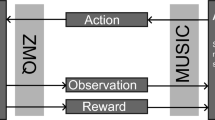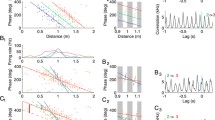Abstract
In 2005, Hafting et al [1] reported that some neurons in the entorhinal cortex (EC) fire bursts when the animal occupies locations organized in a hexagonal grid pattern in their spatial environment. Previous to that, place cells had been observed, firing bursts only when the animal occupied a particular region of the environment. Both of these types of cells exhibit theta-cycle modulation, firing bursts in the 4-12Hz range. In addition, grid cells fire bursts of action potentials that precess with respect to the theta cycle, a phenomenon dubbed “theta precession”. Since then, various models have been proposed to explain the relationship between grid cells, place cells, and theta precession. However, most models have lacked a fundamental, overarching framework. As a reformulation of the pioneering work of Welday et al [2], we propose that the EC is implementing its spatial coding using the Fourier Transform. We show how the Fourier Shift Theorem relates to the phases of velocity-controlled oscillators (VCOs), and propose a model for how various other spatial maps might be implemented. Our model exhibits the standard EC behaviours: grid cells, place cells, and phase precession, as borne out by theoretical computations and spiking-neuron simulations. We hope that framing this constellation of phenomena in Fourier Theory will accelerate our understanding of how the EC – and perhaps the hippocampus – encodes spatial information.
Access this chapter
Tax calculation will be finalised at checkout
Purchases are for personal use only
Preview
Unable to display preview. Download preview PDF.
Similar content being viewed by others
References
Hafting, T., Fyhn, M., Molden, S., Moser, M., Moser, E.: Microstructure of a spatial map in the entorhinal cortex. Nature 436(7052), 801–806 (2005)
Welday, A.C., Shlifer, I.G., Bloom, M.L., Zhang, K., Blair, H.T.: Cosine Directional Tuning of Theta Cell Burst Frequencies: Evidence for Spatial Coding by Oscillatory Interference. Journal of Neuroscience 31(45), 16157–16176 (2011)
Moser, E., Kropff, E., Moser, M.: Place cells, grid cells, and the brain’s spatial representation system. Annu. Rev. Neurosci. 31, 69–89 (2008)
Blair, H., Gupta, K., Zhang, K.: Conversion of a phase- to a rate-coded position signal by a three-stage model of theta cells, grid cells, and place cells. Hippocampus 18(12), 1239–1255 (2008)
Burgess, N., Barry, C., O’Keefe, J.: An oscillatory interference model of grid cell firing. Hippocampus 17(9), 801–812 (2007)
Krupic, J., Burgess, N., O’Keefe, J.: Neural Representations of Location Composed of Spatially Periodic Bands. Science 337(6096), 853–857 (2012)
Fuhs, M.C., Touretzky, D.S.: A spin glass model of path integration in rat medial entorhinal cortex. The Journal of Neuroscience 26(16), 4266–4276 (2006)
Solstad, T., Moser, E., Einevoll, G.T.: From grid cells to place cells: a mathematical model. Hippocampus 16(12), 1026–1031 (2006)
O’Keefe, J., Burgess, N.: Dual phase and rate coding in hippocampal place cells: theoretical significance and relationship to entorhinal grid cells. Hippocampus 15(7), 853–866 (2005)
McNaughton, B., Battaglia, F.P., Jensen, O., Moser, E., Moser, M.: Path integration and the neural basis of the ’cognitive map’. Nature Reviews Neuroscience 7(8), 663–678 (2006)
Blair, H., Welday, A.C., Zhang, K.: Scale-Invariant Memory Representations Emerge from Moire Interference between Grid Fields That Produce Theta Oscillations: A Computational Model. Journal of Neuroscience 27(12), 3211–3229 (2007)
Zilli, E.A.: Models of grid cell spatial firing published 2005–2011. Frontiers in Neural Circuits 6(16), 1–17 (2012)
Conklin, J., Eliasmith, C.: A Controlled Attractor Network Model of Path Integration in the Rat. Journal of Computational Neuroscience 18, 183–203 (2005)
Koch, C.: Simplified models of individual neurons. Biophysics of computation (1999)
Eliasmith, C., Anderson, C.H.: Neural engineering: Computation, representation, and dynamics in neurobiological systems. MIT Press, Cambridge (2003)
Eliasmith, C., Stewart, T.C., Choo, X., Bekolay, T., DeWolf, T., Tang, C., Rasmussen, D.: A Large-Scale Model of the Functioning Brain. Science 338(6111), 1202–1205 (2012)
Ji, X., Kushagra, S., Orchard, J.: Sensory updates to combat path-integration drift. In: ZaÏane, O., Zilles, S. (eds.) Canadian AI 2013. LNCS (LNAI), vol. 7884, pp. 263–270. Springer, Heidelberg (2013)
Mathis, A., Herz, A.: Optimal Population Codes for Space: Grid Cells Outperform Place Cells. Neural Computation 24, 2280–2317 (2012)
Rolls, E.T., Stringer, S.M., Elliot, T.: Entorhinal cortex grid cells can map to hippocampal place cells by competitive learning. Network: Computation in Neural Systems 17(4), 447–465 (2006)
de Almeida, L., Idiart, M., Lisman, J.E.: The input–output transformation of the hippocampal granule cells: from grid cells to place fields. The Journal of Neuroscience 29(23), 7504–7512 (2009)
Author information
Authors and Affiliations
Editor information
Editors and Affiliations
Rights and permissions
Copyright information
© 2013 Springer-Verlag Berlin Heidelberg
About this paper
Cite this paper
Orchard, J., Yang, H., Ji, X. (2013). Navigation by Path Integration and the Fourier Transform: A Spiking-Neuron Model. In: Zaïane, O.R., Zilles, S. (eds) Advances in Artificial Intelligence. Canadian AI 2013. Lecture Notes in Computer Science(), vol 7884. Springer, Berlin, Heidelberg. https://doi.org/10.1007/978-3-642-38457-8_12
Download citation
DOI: https://doi.org/10.1007/978-3-642-38457-8_12
Publisher Name: Springer, Berlin, Heidelberg
Print ISBN: 978-3-642-38456-1
Online ISBN: 978-3-642-38457-8
eBook Packages: Computer ScienceComputer Science (R0)




